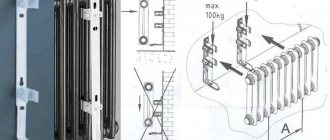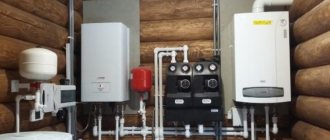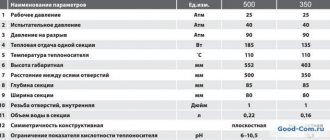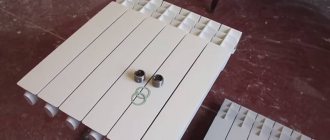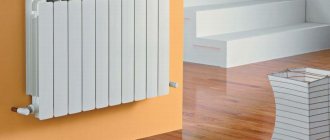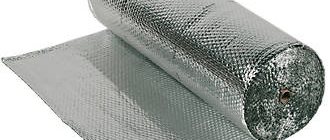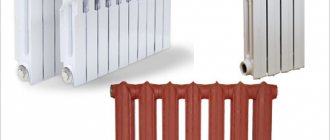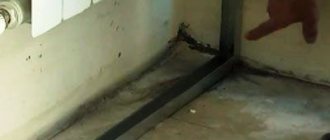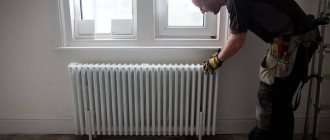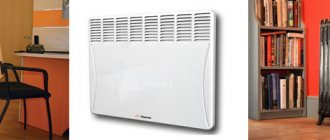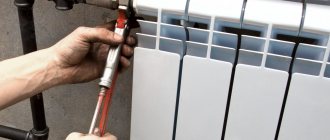How to choose wall brackets
It is not necessary to use the fasteners from the kit to the purchased heating radiator.
You can find a lot of bracket options on sale:
- with adjustment of installation parameters;
- reinforced - for batteries with heavy weight;
- decorative;
- floor;
- wall-mounted, at least two dozen more devices.
They are available in any construction supermarket, in Leroy Merlin, Epicenter. It’s even better to contact a specialized heating equipment salon, for example, Rifar, where there are examples of installed brackets with radiators.
Do you like to do everything at home with your own hands?
When choosing a bracket you need to consider:
- Fastening strength. You need to make a choice, choose a wall or floor installation option. The weight of the body with water is quite considerable, even for aluminum models. Therefore, if the walls in the house are finished with plasterboard, then it is better to choose a floor model;
- Difficult to install. The radiator bracket should not be too difficult to install and adjust, otherwise it will be difficult to correctly align the position of the heating battery relative to the water drain line;
- Possibility of adjusting the distance of the heating surface of the radiator from the wall and window sill board.
Experts call the last condition the most important of all those given. Maximum heat transfer is achieved only if the distance provides the best flow rate of warm air in the gap between the wall and the rear surface of the radiator. It is not always possible to align the radiator relative to the wall correctly the first time. Therefore, the problem is solved with the help of adjustable brackets.
When planning to hang on wall brackets, it is necessary to leave a gap between the top edge of the radiator and the base of the window. For aluminum and bimetallic models, the gap must be at least 100 mm, for cast iron batteries - up to 20 mm.
The gap between the wall and the heating surface is recommended within 30-50 mm, selected individually. If the coolant temperature is no more than 60 °C, for example, when using an individual heating boiler, then the gap is reduced to 20 mm. The higher the temperature of the battery, the greater the distance from the wall should be.
Conclusion
Installing heating radiators yourself is not such a difficult task. Guided by the advice given above and the information in the video in this article, you will be able to cope with this. And if you have any questions, welcome to the comments, I’ll help in any way I can.
It is quite possible to install a radiator with your own hands.
| Gaps. | |
| Standards. |
Bracket for cast iron radiators
Cast iron batteries were traditionally hung on hooks made of forged or stamped reinforcement. They were driven into the brick wall at least 20-30 cm, which ensured reliable fixation of the radiators. Although such brackets looked rough, they were able to withstand the record weight of a cast-iron radiator without subsidence.
Installing the drive-in brackets required skill and experience. Each hook was driven into the wall according to preliminary markings so that the battery rested with the necks of the registers on its concave part without sagging. It was difficult to do this, so each hook had to be wedged. The slope of the drain line was adjusted in the same way.
Anchor hooks
In houses with concrete walls, cast iron radiators are placed on anchor brackets. They are no longer driven in, but threaded into a dowel driven into the wall.
This scheme makes it possible to position the cast-iron radiator more accurately and, if necessary, turn the brackets so that the heating surface of the radiator is parallel to the wall.
Anchor brackets are used to attach all types of radiators, so when purchasing you need to pay attention to the material of the hook and the maximum load. For cast iron batteries, forged steel models with a diameter of 10 mm and a working load of up to 50 kg are suitable.
Wall Welded Brackets
Each fastener is a mounting strip in the form of a pair of steel hooks, 4 mm thick, welded to a support strip 20 mm wide of the same metal. The distance between the supporting surfaces is 30 cm or 50 cm, the overhang of the supporting surface of the bracket is 80 mm and 95 mm.
Mounting strips can be installed on any type of wall; fastening is done using dowels or bolts. If it is a cast iron battery, it is mounted on a wall inside the room.
Fastening cast iron radiators with mounting strips has its nuances.
Namely:
- It is necessary to accurately mark the position of the brackets on the wall. If a mistake is made, both planks will need to be moved.
- After marking, the brackets are secured to the wall with dowels through the upper holes.
- The radiator is hung on the slats, its position is leveled, and only then the drilling locations on the wall for the lower holes are determined.
Any other methods of installing mounting strips require the use of a ready-made jig template. This option is used in residential construction.
Work technology
Owners of private houses can replace radiators at any time convenient for them. To do this, just turn off the boiler and drain the water from the heating circuit. But in an apartment in a multi-storey building, the replacement of the radiator will have to be previously agreed upon with the servicing utility organization.
If all installation work is carried out in the summer, when the heating is turned off, there will be fewer difficulties. However, you will still have to clarify whether water was drained from the system or not.
Please note that many experienced mechanics advise replacing radiators while the central heating is running. This is done because when the coolant is supplied to the circuit under pressure, you can immediately check the functionality of the radiator - if the installation was carried out incorrectly, leaks will occur.
The efficiency of their operation will depend on how well the radiators are mounted to the floor or to the wall. The fasteners must be installed absolutely level, since if they are skewed, problems may arise when connecting the system.
Using available means - a pencil, a level, a plumb line and a tape measure - perform the initial markings. Mark the central axis of the window, which should coincide with the middle of the radiator. A horizontal line is drawn through this point along which the upper supports will be attached.
In cases where there is only one lower support element, it is mounted on the central axis. If there are several of them, another horizontal line is drawn parallel to the top line. After marking, begin drilling holes and installing brackets.
Bracket for bimetallic radiators
The weight of bimetal batteries is several times less than cast iron registers, so there is no particular need to drive long, forged “crutches” of reinforcement into the wall. Bimetallic heating systems with a large number of registers are often secured using pin hooks.
This hook is similar in design to an anchor for a cast iron heating radiator, but its dimensions are smaller, and the depth of immersion in the wall is halved. The support arc is covered with plastic or silicone.
Bimetallic heating radiators are also installed on plate corners.
The mounting scheme for panel steel heating radiators is somewhat different. A standard steel panel is attached by hanging loops welded to the back of the radiator to several steel brackets pre-sewn to the wall with dowels. The number of brackets and hinges depends on the length of the heating radiator.
The steel radiator bracket is a steel angle with perforated mounting holes. During installation, the heating panel is laid in loops on the teeth with inserts. Oval holes for dowels allow you to adjust the position of the dowels, and different sizes of corner shelves make it possible, if necessary, to unfold the fasteners and place the body at different distances from the load-bearing wall.
Types and features of batteries
- Cast iron radiators are characterized by thick walls and resistance to corrosion. They retain heat for a long time and have a long service life. However, it is the large weight of these products that makes it necessary to make the most durable fastenings and supporting stands for them.
- Steel batteries are light in weight, which makes their installation not difficult at all. But they are short-lived and quickly lose heat.
- Aluminum products for the heating system are attractive in appearance, the installation of which is also simple due to their light weight.
- Bimetallic radiators are considered the most universal, combining the properties of steel and aluminum structures. Their installation is also not labor-intensive.
Bracket for aluminum radiators
For lightweight heating systems made of aluminum, corner types of fasteners are used. This can be a regular stamped steel corner or a more complex welded version with a height-adjustable supporting surface.
As a rule, aluminum radiators are supplied with universal brackets with a double arc. This scheme makes it possible to install batteries on any walls, without restrictions. But the strength of universal systems is noticeably lower than custom-made steel angles.
The manufacturer limits the load per point to 30 kg. Therefore, before assembling the heating system, you need to recalculate the total weight of the registers. If the battery is too long, you have to order additional fasteners or use special floor brackets for heating radiators.
Types of fasteners
When choosing fasteners for radiators, you need to focus on the convector model. The brackets allow you to qualitatively fix the heating element in the required place. To mount heating radiators, wall holders are best suited. Floor fastenings are used as additional ones, less often as main ones. Such brackets will be needed when the niche is not suitable for installing a battery or design ideas require such an implementation.
When to Use Floor Brackets
The heating system of the house is planned in such a way that the radiators are located around the perimeter of the room, blocking heat loss through window openings, balcony doors, and main walls. But it is not always possible to use walls as a load-bearing surface for fastening.
In such cases, floor fasteners are used:
- the use of panoramic windows from ceiling to floor in the room;
- if the walls are lined with lightweight materials that cannot be used as a supporting base for heating radiators;
- for temporary placement of a heating system.
The last case is the most common. Major renovations in a room are impossible without a properly functioning heating system. To plaster the walls, you have to remove the heating system. But the plaster will not dry if the water heating system does not maintain 18-20 oC for a week.
Floor brackets are used for modern cast iron batteries due to their heavy weight or due to the specific interior of the room. In this case, the fastenings are structurally combined with the supply of the heating system.
In what cases is it better to select fasteners individually?
First of all, the choice of fastenings depends on the weight of the radiators, the material of the walls and their condition. If the first is taken into account when designing standard fastenings, then it is currently impossible to produce universal elements suitable for any wall material (especially if it is an old wall in poor condition).
During restoration work, the desire to preserve historical authenticity and apply modern technologies for heating rooms forces restorers to select the necessary mounts for radiators. The same applies to the renovation of an old house and public building, where dilapidated wooden walls and floors of dubious quality force a combination of standard fasteners to securely fix the heating system. When designing and constructing modern buildings, where design ideas come into conflict with engineering pragmatism, limited by GOST and SNiP standards, a compromise has to be sought.
You can determine whether the complete mounts are suitable for your conditions only by studying which brackets are used in each case.
Heat transfer from heating radiators: comparison and calculation methods
How to hang a heating radiator on brackets
Installation can begin only after the final assembly of the radiator. The finished body will help determine the anchor points of the hooks.
Determine the drilling points on the wall for the hook-brackets. You can transfer the markings to the wall using a template or through the gap between the registers. We attach it to the wall and note the risks of connecting the heating system pipes. It is best to install the case on a temporary stand.
Using a building level, you will need to set the drain slope and transfer the line to the wall. We remove the body and mark the drilling points for the dowels on the line.
We drill holes to a depth of at least 70 mm, hammer in the plugs and screw in the brackets.
All that remains is to hang the heating radiator and make sure that the slope of the housing corresponds to the previously marked drain line.
Problems of insufficient fastening of batteries to the wall
Correct and reliable fastening of heating devices to the wall is a guarantee of peace and well-being of apartment residents. Insufficient fixation of batteries, especially in combination with the following factors, can lead to deformation of the product or depressurization of seams, which will cause leaks. That is why it is very important to install them correctly and reliably.
So, the factors that aggravate the improper fastening of batteries:
- mechanical damage to devices during their operational life;
- distortions of heating radiators when filling them with water.
Rules for mounting the holder
The ideal placement of the heating device is considered to be in the center of the window opening. For efficient heating of the room, the holders are mounted at a certain distance:
- about 100-150 mm from the floor;
- 40-50 mm from the wall;
- at least 90-120 mm to the window sill.
Most often, radiators are placed under windows
For successful marking, it is necessary to determine the middle of the window opening and mark this place with a level. Further calculations depend on the wiring:
- in the case of lower wiring, a horizontal line parallel to the floor surface is marked;
- with a lateral connection, the calculation is carried out based on the position of the upper supply pipe - the horizontal is marked parallel to the axis of the supply pipe.
The distance between the points of the holder is transferred to the marked horizontal lines; for greater accuracy, you can attach the bracket directly to the mounting surface. Upon completion of installation work, the reliability of the system is checked by light pressure from top to bottom. There are three main types of radiator connections:
- lateral one-sided - the most common option. The supply pipe is connected to the upper pipe, which discharges, respectively, to the lower one;
- lower. Used if the heating system is hidden in the floor;
- diagonal. The best option for long radiators. The supply pipe is connected to the upper pipe on one side, and the outlet pipe is connected to the lower pipe on the other side.
Fixed type bracket
Selection of heating devices by type and power
If you have not yet purchased batteries, then before installation you need to select heating radiators from 4 varieties available for sale:
- Sectional aluminum. They are made from a light alloy - silumin (aluminum + silicon) in the form of ribbed sections, painted with a heat-resistant polymer composition.
- Bimetallic heaters are made in two types - sectional and monolithic, although outwardly the finished batteries look the same. Construction: a frame made of steel pipes is embedded inside each silumin section.
- Cast iron heating devices - designer and Soviet-style - are only available in sections.
- Steel radiators are welded from stamped metal (panel) or made by casting (tubular).
Note. In addition to the heaters shown in the photo, there are copper and baseboard convectors. They are rarely used in water systems.
Select the type of heating devices according to two criteria: price and appearance that matches the interior of the rooms. One caveat: for the autonomous heating system of a private house, any batteries are suitable, and for an apartment with centralized heating - radiators that can withstand a pressure of 12 bar. How to choose heaters is described in detail in a separate instruction.
The heat dissipation of batteries and registers is specified in the manufacturer's technical documentation. According to current standards, the power of radiator sections is indicated when the temperature difference between the coolant and room air is 70 °C.
For example, the room temperature is 20 degrees, the water in the pipes is 90 °C, then the section will give off approximately 180 W of heat. Since the coolant rarely heats up to 80-90 °C, the actual heat transfer will be much lower. Hence the conclusion: take radiators with a margin of 80-100%. Simplified methods for calculating power are described in our material and in the video:
Almost all types of batteries are offered in 2 versions - with side or bottom connection. Here the choice depends on the method of laying the pipes and the arrangement of the connections. This means that before installation you need to consider the question...
Wood screens
Wooden battery screens are made from beech and oak. They are said to be reliable and durable decorative structures. Screens are optionally painted, enameled or tinted.
For better heat transfer, they are raised above the floor, and holes are made on the box, which increases air circulation.
- In children's institutions, this is the most common decorative option for radiators.
- A model made of slatted material will be cheaper, and the function of heat exchange and protection against burns will be just as good.
- With a rail thickness of 28 mm, the price of the screen starts from 1.4 thousand rubles. per linear meter.
- The cost increases to 1.6 thousand rubles. for 1 linear meter, if the slats are varnished.
The designer robot models look very nice. But the price for them will increase significantly. If you wish, you can try and find where to buy a screen for a radiator made of MDF with imitation of valuable wood.
This model looks impressive, but the price is much lower than that made from natural wood. So screen size 55 - 70 mm perforated HDF panels cost 1.2 - 5.5 thousand rubles. taking into account the size of the structure. If the grille is made of rattan, then the screen will cost from 2.0 thousand rubles. up to 5.5 thousand rubles.
Metal screens
Metal decorative screens for radiators are made from steel or aluminum mesh, which does not interfere with heat transfer. The larger the holes, the better the heat passes through. Because it does not linger in a closed space.
Despite the fact that the thermal conductivity of the metal is good, the thermal power has dropped due to the small surface of the structure.
The metal screen is easy to install. Different colors and patterns on it will satisfy any needs. They come in flat form and in a box with an openwork lattice.
The price is influenced primarily by the screen size. The largest height of the hanging screen can be 850 mm, and the length up to 2000 mm.
- If a large structure is needed, it is made of several parts.
- A screen with a height of 800 mm, with a length from 700 mm to 1500 mm costs from 2 thousand rubles. up to 4.3 thousand rubles;
- A height of 600 mm with the same height parameters costs from 1.8 thousand rubles. up to 3.9 thousand rubles;
- And a height of 400 mm costs 1.7 thousand. rub. – 3.6 thousand rubles.
The installation process itself
Before starting work, it is necessary to completely shut off the heating circuit, drain the water from the system, and the pump will help remove any remaining water efficiently. Using a level, carefully check the battery hung on the supports vertically and horizontally.
- You need to unscrew all plugs from the device.
- Connect a valved bypass, which is only required for a single-pipe circuit. To connect to a two-pipe circuit, a bypass is not needed; only a squeegee with a valve connected to it is used for connection.
Using threaded connectors, we connect the battery to the system, using tow or another sealant to seal the joints (if you have experience in welding, the joints between the connectors and the pipeline can be welded).
It is important to note that until the installation is completed from aluminum. bimetallic and steel devices do not need to remove the packaging shell
Installation is complete, but some more pressure testing will be required. To do this, you will need to call a plumber. Both his experience and the device will be useful, which does not make sense to buy for the sake of installing several batteries.
